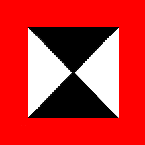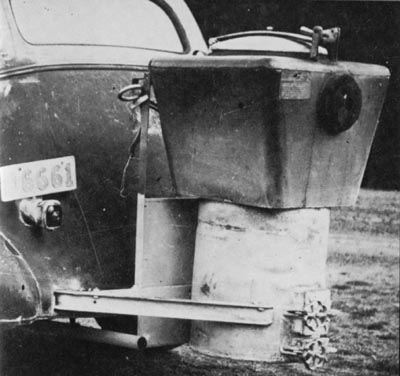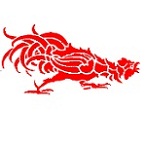Steve Wilcox
Posts: 103
Joined: 8/17/2001
From: Victoria, BC, Canada
Status: offline

|
Came across this somewhere in the past. I've moved the lengthy header down to the bottom, so it doesn't get in the way, but wanted to include it so proper source credit is given. It appears to be a newsgroup message, but I got it from the Internet, not from a newsgroup, and I have no clue what the link was anymore. I had it saved as a Notepad file, so here's the copy & paste:
"In regards to the Schürzen used on German armoured vehicles from 1943
onwards, it might be interesting to look at how these are described by
authors Jentz and Spielberger in the last 40 years or so.
Jentz and Spielbergers version of events is as follows:
********'
17. February 1943: The "Panzerkommision" decides to propose to Hitler that
tanks (model and type not mentioned) be equipped with 5mm plates on the
sides and 10mm plates on the turret. Extra weight: 600kg.
20. February 1943: Driving tests at Kummersdorf followed by firing tests.
Both 5mm plates and wiremesh skirts are tested. Both succesfully defeats
Soviet 14.5mm AT-rifle rounds at 100 meters and 7,5cm HE with contact
detonator fired with charge 2. Plates were preferred because the attachments
were already designed. Wiremesh were just as effective and even lighter but
would have taken longer to get in production.
6. March 1943: Hitler is briefed on the results from Kummersdorf. All
Panthers, Panzer IIIs, Panzer IVs and Stugs are to have skirts mounted
during production. Vehicles already delivered should have skirts retrofitted
ASAP.
**********
The authors continuously stresses that HEAT/Hollow charge ammunition was not
tested and that Schürzen was not intended to protect against this type of
ammunition.
Lets take a brief look at the story as it develops in the Jentz/Spielberger
books.
I am pretty shure that they are first mentioned by Spielberger in an article
in the German magazine "Feldgrau" in 1963 that Senger- und Etterlin copied
for his book "Die Deutschen Panzer 1926-1945" that appeared in the
mid-60ies. My example is a 3. Auflage from 1968. There is no development in
the story when it is repeated in Spielbergers book on the Panzer III which
is, I believe, from the late 1970ies. My copy is 3. Auflage from 1990.
In this version it is said that the purpose of Schürzen was to strengthen
the armour protection of the sides of the tank, primarily against anti-tank
rifles ("Panzerbüchsen") and hits by hollow charge ammunition
("HL-treffer"). It only refers to the presentation of the tanks with
Schürzen to Hitler on March 19th 1943, not the actual tests.
A very interesting comment is found in Spielbergers book on the Panther. My
copy is 4. Auflage from 1994, but obviously the 1st print is earlier,
perhaps the late 1980ies? Anyway, on page 86 Spielberger discusses the
various forms of additional armour used as part of a general discussion on
armour and weldings etc. Here he mentions tests in 1942 of the so-called
"Schottpanzerung" which I believe can be translated simply as spaced armour.
These tests were conducted with APCR as well a hollow-charge weapons. Later
it is said that this Schottpanzerung was usefull against hollow charge
ammunition and magnetic mines ("Hafthohlladungen"). But there is no
references to actual documents, dates and places, it is simply a general
comment by the author.
The next development comes with Spielbergers book "Sturmgeschütze" in the
early 1990ies (my copy is 2. Auflage from 1994). Here Tom Jentz is credited
as well. In this version, Schürzen is first discussed at the Führerkonferenz
February 6./7. 1943. It then goes on to described in some detail the firing
tests at Kummersdorf on February 20th mentioning only AT-rifles and
high-explosive ammunition. The author adds that Schürzen were not tested
against HEAT nor were they intended to protect against this type of weapon.
In other words, Spielberger has now changed his mind about the Schürzen
being intended to protect against "HL-treffer". Why we may ask. I can only
guess, but it seems to me that in the 1960ies, Spielberger only had the
references from the Führerkonferenz to go by, not the February 20th
Kummersdorf data. So he choose to repeat the Anglo-American contention that
Schürzen was intended for protection against HEAT as well. But please notice
that AT-rifles has been mentioned all along.
Then in 1995 comes Tom Jentz' book on the Panther where Schürzen becomes a
very important component in the development of the Panther tank. On page 35
Jentz refers to Schürzen and again says that they were tested only against
75mm high explosive rounds and anti-tank rifles and "The invention of
Schürzen saved the Panther I. If the Panther had not been able to cope with
anti-tank rifles, prodcution would have been converted to the Panther II.
Schürzen were not intended to defeat and were not *initially* tested against
hollow charge rounds." No reference is given, but later, on page 50ff there
are some vague references to conferences with Speer early in 1943 in
conjunction with Schürzen. In reference to a meeting in Speers ministry on
April 29th 1943 it is said that the Panther I with Schürzen now had
sufficient protection against close range fire from the Soviet 14.5mm
anti-tank rifle. It does not have the character of a direct quote, so it is
difficult to see what is take directly from the documents and what is Jentz'
own opinion.
Moving on, we reach what I believe is the latest on the matter from
Spielberger/Jentz, "Begleitwagen Panzerkampfwagen IV" where the story
appears like the quote at the start of this post. This time the references
are clear but basically restates what was said in Spielbergers book on
Sturmgeschütze. This book is from 1998.
If you consider the actual references to original documents in Spielberger
and Jentz books to be true, then there can be little doubt that Schürzen
were originally intended as protection against the Soviet 14.5mm AT-rifle
and direct fire by high explosive ammunition. That does not rule out that
they were effective against HEAT.
If you want to refute the development history of Schürzen as portrayed by
Jentz and Spielberger, you would need some documentation that they have
either misunderstood what they read or that the data they have are
incomplete and of course produce the documents that would show this. As far
as I know, no one has done this.
The next thing we might want to look at is how the story emerged that
Schürzen were designed to combat HEAT-type weapons. Robert Livingston has
suggested the following explanation:
************************
A reprint of US Army intelligence reports
(1944-45) on German weapons says:
"The Germans have recently begun attaching thin skirting armor plate of
from 5 to 8mm thickness on various fighting vehicles, including the
Sturmgeschutz. The following theories have been advanced for this
development:
1) to break up or deflect 20mm tungsten carbide core ammunition
2) to defeat hollow charge shells
3) to defeat the 14.7mm (sic) Russian antitank rifle
4) to defeat the American Bazooka"
Now, by the time Col. Robert Icks completed _Tanks And Armored Vehicles_
in 1945, he had decided that the plates were for "protection against the
American "bazooka"." This book was probably the first work available to
the public describing the major and minor WWII tanks. The photos are
first rate, even by today's standards. It was printed on thin paper due
to wartime restrictions. A huge number of copies were printed and one
can still find copies for sale today.
A compilation of sheets detailing the Aberdeen Museum collection, dating
from right after the Korean War, states the plates were "antibazooka"
shields. The myth was firmly in place.
I think it was American myopia which fostered and spread this myth. They
thought the Bazooka was so effective that the Germans must have been
threatened enough to haul around a few thousand pounds of extra steel to
protect themselves. It was accepted wisdom in those circles that the
anti tank rifle was dead, obsolete.
*********************
Returning for a moment to John Salts post he lists 4 reasons why the story
brought forward by Spielberger and Jentz is not to be trusted:
***************
1. Look at the material. Shurzen were made of thin mild steel
or wire mesh. In terms of ballistic protection, this is next to
worthless (and possibly worse -- but we'll come to that later).
As a burster plate to detonate HEAT rounds, though, it's fine.
**************
Apparently the tests at Kummersdorf proved otherwise. Any particular reason
to discount those? Paul Lakowsky can explain these things better than I can,
but the protection element seems to be that Schürzen will cause slow down
the projectile, damage the 14.5mm round and cause it to tumble. In other
words, reduce it to an ineffective lump of metal.
****************
2. Look at the positioning. If the intention were to act as
spaced armour and do the normal job of cap-stripping or
penetrator-breaking, there would be no need to mount the Shurzen
plates on those cumbersome rails far from the main armour. It
would have made more sense, and saved weight, to mount the armour
closer, in the style of the Pz III driver's plate. There is no
need to undergo the risk of plates getting knocked off in close
country -- as often happened in Normandy -- unless it is desired
to obtain a good, long stand-off distance, as one would against
HEAT.
******************
Placing Schürzen in between the roadwheels and return rollers of the Panzer
III and IV would require a lot more work on the plates, it would require
different plates for different vehicles, it would hamper maintenance and
repair and would very likely cause problems with mudpacking. It would be a
vastly more complicated affair than simply hanging the Schürzen on a rack as
it was done.
******************'
3. Look at the HEAT threat. It has been alleged that there was
no significant HEAT threat to German tanks on the Russian front
when Schurzen were first fitted. Not true; apart from artillery
weapons, the Russians fielded the 82mm aircraft rocket and the
similar LMG rocket-mine. Bazookas were also sent to Russia by
lend-lease, and captured Panzerfausts were used when obtainable.
******************
I dont know how many Bazookas were sent to the USSR, but according to
Zaloga, they did get 1000 PIATs. However, I dont think it would have been an
issue in February 1943, and certainly not a "significant threat". A more
likely HEAT threat in the east would be the HEAT rounds fired from 76.2mm
and 122mm artillery pieces.
But you really dont need a threat. Zimmerit was applied to counter magnetic
mines that, to my knowledge, was never developed or used by allies.
*******************
4. Look at the ATR threat. The penetration performance of PTRS
and PTRD rounds was marginal against the 30mm side armour of the
Pz III or Pz IV Ausfs of the mid-war period onward (I cheerfully
refer readers to Tony Williams' excellent book, "Rapid Fire",
Appendix 1, which gives the most generous penetration performance
for these weapons of any source I know). It must be borne in
mind that a significant overmatch of the armour is needed to
stand a good chance of a kill.
******************
I've seen figures giving 35mm and 40mm at 300 meters against vertical plate.
Reduce range to 50 meters, I think both the Panzer III/IV and Panther would
be at risk. The point is that AT-rifles was available in some numbers and
they were used by the infantry when in immidiate contact with armour (at
least this is the situation I've seen in German training films). So just
like the Panzerfaust, PIAT and Bazooka, it is a close defense weapon.
We may also consider that Schürzen was used on other vehicles like the
Jagdpanzer IV and the Hetzer. In case of the Hetzer, they only protect the
lower hull which is a measly vertical 20mm. They do not protect the upper
hull which is an equally measly 20mm albeit with a 40 degree slope. Would
not the upper hull be easily penetrated by Bazookas, captured Panzerfausts
or HEAT artillery rounds? Does not the same apply to the Jagdpanzer IV (40mm
at 30 degrees)?
To say that the AT-rifle was not a threat is to refute the documents qouted
by Jentz and Spielberger. So the issue really becomes a matter of whether
you believe those quotes or not.
Mind you, niether author says that Schürzen was not effective against HEAT,
the argument is that they were not developed to counter that specific
threat.
John, do you have any contemporary German evidence suggesting that
Spielberger and Jentz are wrong?
Claus B
Paul Lakowski <psl@interchange.ubc.ca> skrev i en
nyhedsmeddelelse:de5bf54f.0110261517.55877d2d@posting.google.com...
> cray74@hotmail.com (Mike Miller) wrote in message
news:<5dcb47db.0110260556.1019019@posting.google.com>...
>
>
> >
> > That's two people now who have claimed the Schurtzen plates were
> > to disrupt Soviet 14.5mm anti-tank rifles, while another has
> > called it nonsense. What's the story? I've only heard of the
> > armor skirts being used to defeat HE and HEAT.
>
>
> Yes this is true , read Speilberg on Stug development, he states they
> were tested to defeat 14.5 HVAP which shattered resulting in no
> damage to the 30mm side hull armor. HE rounds were also tested but he
> specifically states that no shaped charges where tested against these
> spaced plates before they where ordered into production in feb 1943.
>
> Robert Livingston traced the rummor of anti heat sheilds to a post war
> US analysis that seems to have persisted for decades.Infact these
> space plates would have increased the penetration of some HEAT
> warheads as they had insufficent standoff to start with.
>
> BTW John Salt, I must say I like your website. From what I've read the
> hardened plate is essential in destroying the nose of sharp
> penetrators which is at the heart of their success.With the caped
> penetrator the nose became blunted and there was less of a shock to
> the penetrator. I gather it has to do with the 'plastic wave velocity'
> of the penetrator material being exceeded. The more pointed the
> penetrator the easier this is to achieve. Once started it won't stop
> until the penetrator has a cylindrical nose shape.
>
> On the other hand once a certain level has been exceeded harder plates
> shear off like adibatic shear in DU penetrators ...so their easier to
> 'plug'.
>
> Its really surprising how much difference these nose shapes make to
> penetration of armor.
</XMP>
<!-- X-URL: nntp://news.newsguy.com/AxzC7.1483$MP2.350801029@news.orangenet.dk -->
<BASE HREF="nntp://news.newsguy.com/AxzC7.1483$MP2.350801029@news.orangenet.dk">
<XMP>
Path:
spln!rex!extra.newsguy.com!lotsanews.com!newspeer.monmouth.com!news-out.visi.com!hermes.visi.com!gemini.tycho.net.POSTED!not-for-mail
Approved:
sci-military-moderated@retro.com
Return-Path: news@superman.mobilixnet.dk
Delivery-Date: Sat Oct 27 07:50:02 2001
Delivery-Date: Sat, 27 Oct 2001 07:47:27 -0700
for <sci-military-moderated@retro.com>; Sat, 27 Oct 2001 07:46:10 -0700 (PDT)
id 15xUTJ-0004ra-00
for sci-military-moderated@moderators.isc.org; Sat, 27 Oct 2001 16:30:02 +0200
Sat, 27 Oct 2001 16:29:53 +0200
To: sci-military-moderated@moderators.isc.org
From: "Claus B" <shermanrules@tankers.net>
Newsgroups: sci.military.moderated
References:
<i3qB7.152293$5A3.52800604@news1.rdc2.pa.home.com>
<a516ee75.0110252036.230ea683@posting.google.com>
<5dcb47db.0110260556.1019019@posting.google.com>
<de5bf54f.0110261517.55877d2d@posting.google.com>
Subject: LONG: Schuerzen: Was WWII Armor types
X-Priority: 3
X-MSMail-Priority: Normal
X-Newsreader: Microsoft Outlook Express 5.00.2615.200
X-MimeOLE: Produced By Microsoft MimeOLE V5.00.2615.200
Message-ID: <AxzC7.1483$MP2.350801029@news.orangenet.dk>
Date: Sat, 27 Oct 2001 16:27:35 +0200
X-NNTP-Posting-Host: 212.97.237.12
X-Complaints-To: abuse@orangedk.com
X-NNTP-Posting-Date: Sat, 27 Oct 2001 16:29:52 CEST
Organization: Orange Internet -- http://www.orangedk.com/
Content-Length: 14085
Lines: 279
NNTP-Posting-Host: 40aca008.newsreader.tycho.net
X-Trace: 1004203395 gemini.tycho.net 431 205.179.181.194
X-Complaints-To: abuse@tycho.net
Xref: spln sci.military.moderated:39870" 
|
 Printable Version
Printable Version





















 .
. 








 New Messages
New Messages No New Messages
No New Messages Hot Topic w/ New Messages
Hot Topic w/ New Messages Hot Topic w/o New Messages
Hot Topic w/o New Messages Locked w/ New Messages
Locked w/ New Messages Locked w/o New Messages
Locked w/o New Messages Post New Thread
Post New Thread